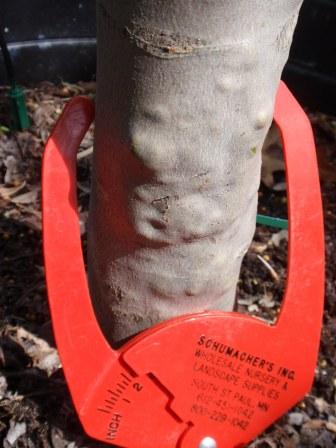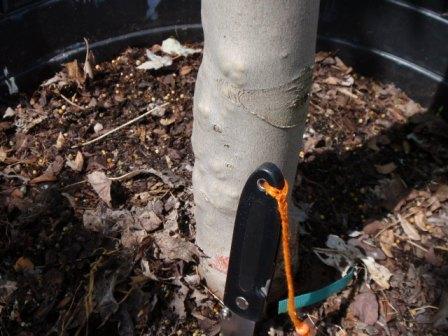OK, this Friday’s quiz is the real deal: everyone gets to play “Extension Specialist for a Day”. I am stumped on this and so are my colleagues here at MSU. I used to work for a guy who liked to say, “None of us is as smart as all of us”. Let’s put it to the test.
The photos below come from a nursery here in Michigan. The trees are container-grown Red sunset maples. Pretty routine crop around here. The trees look fine: good color, full crowns, growing well. The only problem is that nearly all of the trees have bumps along the bottom 8” or so of the trunks. The grower is concerned, and rightly so, about consumer acceptance of the trees. The trees have been examined by a highly qualified pathologist – no evidence of fungal disease; and by a highly qualified entomologist – no evidence of insect activity. The grower is sitting on several hundred of these trees. What should I tell him?

NOTE: The name of the nursery is confidential – they just used the calipers from Schumacher’s in the photo.

Okay, I’ll try a guess. First I’m assuming the trees are roughly 3 or 4 years old in 5 gallon (?) containers. If almost all of several hundred trees show this, and pathologies have been ruled out, it’s got to be a problem with culture. What happened a year or two ago at the nursery? Did the watering system fail; a change in feeding or watering regimen; a cold snap. My horticulture degree is so old, it should be chopped up for mulch, but I’m thinking it’s a cosmetic problem. Looking forward to hearing what others think.
Nanina
i think at some point these guys were buried too low in a container. through re-poting, the problem was discovered and fixed before it was too late. i rescued a dogwood last year that our supplier had buried about 8 inches too low. i just looked at it to check my theory and it does have an obvious difference in the trunk. the dogwood and maple do not have similar growth so it is hard to compare. perhaps some of those bumps on the maple were potential roots before they were saved.
I’m voting for alien eggs laid under the bark that are going to burst forth in a gruesome manner and begin destroying the earth.
Have you cut open any of the bumps to see what it looks like inside?
I’m with Joseph – well, partly. What do the bumps look like inside? And are the bumps all the way around the base or to one side?
I’m thinking about all the people who pick trees up by the trunk rather than the pot. With a maple’s thin bark, could someone with a good grip, a lot of rings, and rough handling do enough damage to a young tree to create scar tissue?
Also, where’s the root flare?
I think people are on to something here, Bert. I agree that there’s been some kind of perturbation to the trunks and that you’re seeing the beginnings of burls. Many times they are induced by environmental factors rather than viruses, pests or disease. Are they clonal, or are they from seed st
ock?
And Paul is spot on. These are buried too deeply if you can’t even see the beginning of the root flare.
It would be interesting to take some cross-sections and look at the tissues under the bumps. Are they multiple buds? Latent roots (as Jon suggested)?
Edema/injury from irregular watering or temperature?
Thanks for the comments folks. This gives me some ideas for some follow-up. I agree the trees were planted too deep but couldn’t quit connect that to the symptoms. If the trees were planted deep enough that it induced some adventitious roots, could it stimulate some abnormal bud activity slightly above ground as well? Certainly worth a look.
Sell them as maples with character.
I’m pretty sure that I’ve seen lumpy trunks before but don’t remember if they were maples. Could tree wrap be the culprit?
Yikes! That truck looks surprising like my one leg with varicose veins. Based on sight alone, I’m guessing it’s vascular.
Is there an answer to this?
I agree with Nanina
We had the same problem with Autumn Blaze Maples and found that the bumps didn’t cause any long term problems.